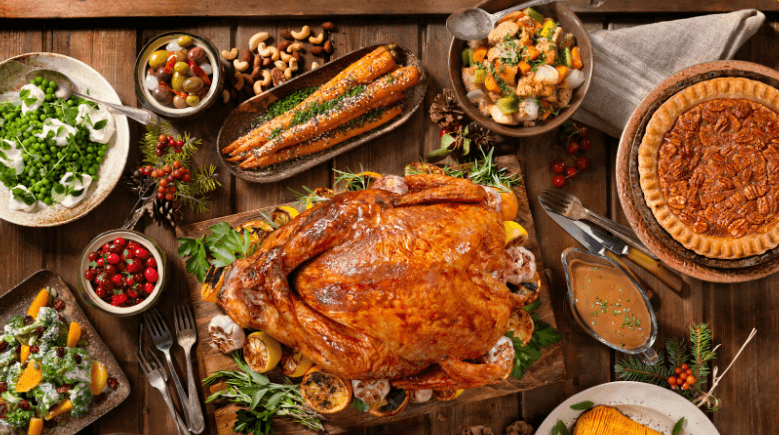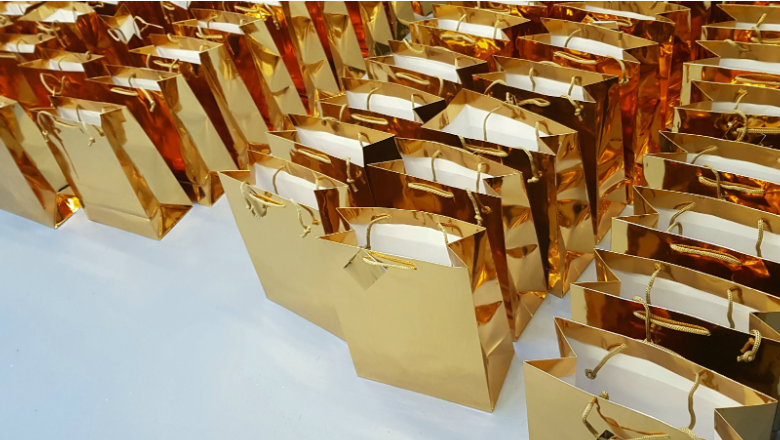The end of the year can be a joyous time for households across the United States. November and December bring a variety of holidays and festivities — such as Thanksgiving, Hanukkah, Christmas or New Years.
As we prepare for treasured time with loved ones, it’s important to remember that celebrating holidays doesn’t have to burden the planet. There are many ways to adjust your holiday customs to reflect your commitment to a sustainable lifestyle.
This holiday season — let’s bring joy to the world by adjusting or adding climate friendly practices. We can forge new traditions without sacrificing the customs that make the holiday season festive and fun.
What is sustainability?
Sustainability is not just a buzzword, but it can have a lot of definitions. Sustainability is one of Enact’s core values and part of our mission to accelerate the transition to clean energy.
A sustainable lifestyle aims to reduce our environmental impact by making positive changes to reduce environmental damage. Sustainability matters to preserve our natural world for future generations to enjoy — and to offset climate change. We can make choices today that will positively impact our planet in the future.
The top ten ways you can sustainably celebrate the holidays
The holidays can be a wonderful time of year to spend time with loved ones — to recharge and reflect on what truly matters. Whether you observe Thanksgiving, Hanukkah, Christmas, New Years or other important holidays — there are steps you can take to sustainably enjoy the holidays.
1. Clean energy means clean holidays
The holidays for many people can see increased electricity usage. Your friends or family might stay over for the holidays. You might cook more delicious meals, hang string lights and set up indoor and outdoor decorations. All of these can add up, increasing both your utility bills and your carbon footprint.
Late fall and winter can also mean increased energy usage for homeowners in the northern hemisphere. Colder outside temperatures and shorter days require many of us to heat our homes and use our lights more. Thankfully, the increased energy consumption doesn’t have to add up.
Solar panels can harness sunlight and generate clean, carbon-free electricity. Home solar energy systems produce low cost electricity and pay for themselves over time. Even in the winter, solar panels can produce low-cost electricity and lower your daytime utility costs.
This not only helps with being more sustainable during the holiday season, but an investment that lasts all year long. Solar panels have warranties that can last up to 25 years — and many continue to power homes even after that.

2. Let there be LED lights
Stringing lights on your roof and landscaping is a great way to add cheer. Switching to LED string lights offers a sustainable way to bring cheer. LED lights are more efficient, use less energy and are longer-lasting than traditional incandescent bulbs.
The U.S. Department of Energy found the U.S. uses an estimated 6.63 billion kilowatt-hours of electricity just during the holiday season to power decorative lights. If every house switched to LED lights, the U.S. could save 5.97 billion kWh of electricity — which is around the annual electrical output of 500,000 homes.
Traditional Christmas and holiday lights use incandescent bulbs, which waste energy — 90% of their energy is released as heat. LEDs use up to 75% less energy and can last 25 times longer, this makes LED lights a cheap, cost-effective option.
For the non bulb lights, used for Advent candles, menorahs or other holidays — use sustainable candles. Sustainable candles can be made from plant-based wax or beeswax.
By making the switch to LEDs, you continue to spread holiday fun and are making a better decision for your wallet and the planet.

3. Eat better, healthier and more sustainably
Food can be an essential part of your holiday customs — whether that’s Thanksgiving turkey, Christmas ham, Hanukkah latkes or other beloved dishes. Our food choices can impact not only our health but also on the planet.
A climate-friendly diet doesn’t mean you have to be vegan, unless you want to be vegan. Climate-friendly diets also aren’t as strict as other diets, like the low-FODMAPs diet. Typically, eating more sustainably involves:
- Increase your intake of plant-based foods — plants take up less energy, water and resources than meat. You can help reduce your carbon footprint and improve your health by adding more vegetables and fruits this year to your Thanksgiving meal.
- Eat smaller portions of meat, dairy and eggs. Animals emit greenhouse gasses into the atmosphere and require a ton of land, water and resources. You don’t need to give up your Christmas ham this year, but you could have smaller portions or have a meat-free day before Christmas.
- Buy locally sourced or seasonal foods, if possible. Eating produce in season helps reduce the energy and resources needed for its storage and transportation, plus it can help local farmers in your own area.
- Eat less processed or packaged foods — this not only improves your diet but means less packaging and waste. Plus making your own foods with whole ingredients can be a fun way to spend time with loved ones.
- Reduce food waste and plan meals in advance, making only what you need. Holiday meals can make good leftovers over the next couple days.
- Look for logos that signal commitment to environmental sustainability and ethical sourcing on your foods. Try looking for terms that actually mean something like USDA certified organic, Non-GMO Project Verified, cage-free or free range, or other terms that are backed by a certification or legal requirement.
For next year’s holidays, you could start a summer garden or a compost bin to further reduce your carbon footprint and lead a more sustainable lifestyle.

4. Gifts that make a difference
Presents are a wonderful way to show your loved ones you appreciate them, but not all gifts are the same. This holiday season — aim for quality gifts that your loved ones will love. Quality gifts can be thoughtful products or experiences that your loved ones value, use less packaging and can avoid the landfill.
You might want to consider gifts that are made from natural, organic or biodegradable materials — or gifts that can be reused or recycled after use. Sustainable gifts can also be products that last a long time and avoid overconsumption, such as a high-quality jacket or backpack. If you want to find gifts on a budget, second-hand gifts can be a wonderful way to have a climate-friendly holiday.
You might want to buy less gifts and opt for higher-quality, more sentimental gifts this season. Not only might this take less time to find a bunch of gifts, but you can invest in timeless gifts that can last for a while. Not only does this improve the experience of receiving gifts, but avoids filling landfills with cheap plastic, broken toys or fast-fashion.
Other sustainable gifts can include experiences. You don’t have to wrap them and for the people that buy themselves anything they want, this can be a great opportunity to show them you care. Gifted experiences can include concerts, educational courses, massages, museum visits, historical or culinary tours — or whatever experience your loved one will enjoy.

5. Oh Christmas tree, oh Christmas tree
Christmas trees have become symbolic of the holiday season for many Americans. American households bought 21 million real Christmas trees in 2021, according to the National Christmas Tree Association. Many more bought or re-used artificial trees that year.
You might want to consider switching to a real tree this year and keep your holidays environmentally friendly. While a real tree does get cut down from a forest, Christmas trees take several years or more to grow and for every Christmas tree harvested — one or more is planted in its place.
Additionally, real trees are biodegradable or can be turned into mulch. This is better for the environment in the long run when compared to plastic trees. While artificial trees can be reused, most are made of plastics that are not biodegradable. The production of these plastic materials can also emit harmful greenhouse gasses into the air.
A third option also exists — you can buy a live, potted tree. Depending on the kind of tree, it can be a year-round houseplant that can be used time and time again — like a tropical Norfolk Pine. Or you can plant the tree after the holiday season in your yard, a park or another place with expressed permission. Many traditional Christmas trees — spruces, firs, pines or junipers — don’t make great houseplants and can add to the natural beauty of your community.
6. Think about your travels
Many Americans travel for the holidays — either to see loved ones or on vacation. Spending in-person time with your loved ones makes the holiday stress worth it, but you can take steps to travel sustainably.
Some ways to travel sustainably this holiday season include:
- Carpool: If you travel by car, you can drive together with family members and reduce the number of vehicles on the roads that emit harmful exhaust. Bonus points if you can carpool with an electric vehicle owner and use less fossil fuels.
- Travel by train or road over flying: Planes can use more fossil fuels than cars or trains. If possible, try taking an Amtrak, public transit or car this season and avoid flying. Sometimes, this isn’t possible and you can check Google Flights for their carbon emissions estimates.
- Find the right lodging: Staying with family or friends can be more sustainable, as it involves less one-time products (think about hotel shampoos and conditioners). Staying with loved ones can be more intimate and lets you get quality time. Sometimes that doesn’t work out and you can find hotels or homestays with sustainability pledges or practices. Some hotels let you re-use your towels and use environmentally friendly products.
- Be a respectful guest: Be conscious of the local environment and only use what you will use. This can mean taking shorter showers, making sure to property dispose of waste and avoiding damaging activities.
- Rent an electric vehicle: If you chose to travel and need a short-term car rental, rent an EV for a more sustainable vacation.
7. Think about how you decorate
Not only are reusable decorations better for the environment, but finding timeless decorations that you love will make every holiday feel like home. Instead of buying cheap, low-quality decorations — aim for longer-lasting decorations that can be stored.
If you get bored of your ornaments or decorations, try sprucing them up with a fresh coat or DIY alterations. Christmas tree ornaments can be painted and decorated with some arts and crafts. For children, you can buy reusable advent calendars and life-long menorahs.
You can look for second hand decorations at thrift stores, antique shops or an online marketplace. This time of year many people donate their old decorations and you can find cheap, sustainable ways to add festivities to your home.
8. Decorate with natural materials
Sometimes the real thing can be better for the environment. For decorations this can mean using a real tree, real evergreen garlands or wreaths, making your own orange and cranberry garlands and using natural center-pieces. Using locally-sourced materials from your property and public lands, you can get creative with loved ones and make festive decorations. You can also go to a local florist or craft store and ask for sustainable materials.

9. Reduce, reuse and recycle your wrapping
Good news for people who dislike wrapping gifts — you can use reusable gift bags and tissue paper. Just make sure you tell your loved one to reuse the bag and paper (or ask for it back). For the gifts that can’t be placed in a bag, aim for biodegradable gift wrap or reusable bows. Get creative with how you present gifts to your loved ones this season and look for climate friendly ways to reduce plastic waste.
If you’re all out of options, you can get better at wrapping gifts with wrapping paper and aim to use less of it. Even if you have to use the less sustainable option, sustainability is a journey and involves finding ways to live better in each moment of life.
10. Paper doesn’t always beat plastic
Instead of buying paper, styrofoam or plastic plates and cutlery this year, aim for real dishware and cutlery. While this might mean more work with washing dishes, you can avoid filling your landfill with garbage. Many people think paper is always biodegradable, but in a landfill environment — paper can sit intact for years.
Leftovers can also be stored in dishes with aluminum wrap or in reusable containers — like Tupperware or an empty, cleaned out yogurt container. When you transport dishes from your home to another, try baking your casserole in a glass, clay or reusable metal dish — instead of disposable aluminum dishes.
If you haven’t noticed a pattern — reduce waste as much as possible and when not, find biodegradable options.
Go solar with Enact
In the case of going solar, being more sustainable can also mean significant monthly savings throughout the year. As you string lights across your roof or host out of town guests, solar can alleviate the costs of increased energy consumption. Solar also reduces your carbon footprint and makes the world a better place.
Enact’s team of home energy advisors specializes in designing personalized solar panel systems tailored to both energy needs and budget. To obtain a free solar quote, customers need to complete a brief questionnaire and submit their latest utility bill. Enact prioritizes customer choice, allowing them to select solar equipment and financing options during a complimentary consultation. The company stands out by providing access to a diverse range of solar panels, inverters, and storage battery manufacturers, fostering transparency through the Enact platform for real-time installation tracking.
In contrast to traditional solar installers, Enact values customer feedback, enabling swift adjustments to the system design to meet current or future needs. Following this, the company coordinates the solar installation process, promising customers the ability to go solar within approximately ten weeks. With a custom system in place, customers can potentially save thousands of dollars. Enact encourages individuals to embrace solar energy as a valuable addition to their homes and lives, emphasizing the importance of choosing the right system with their services.

